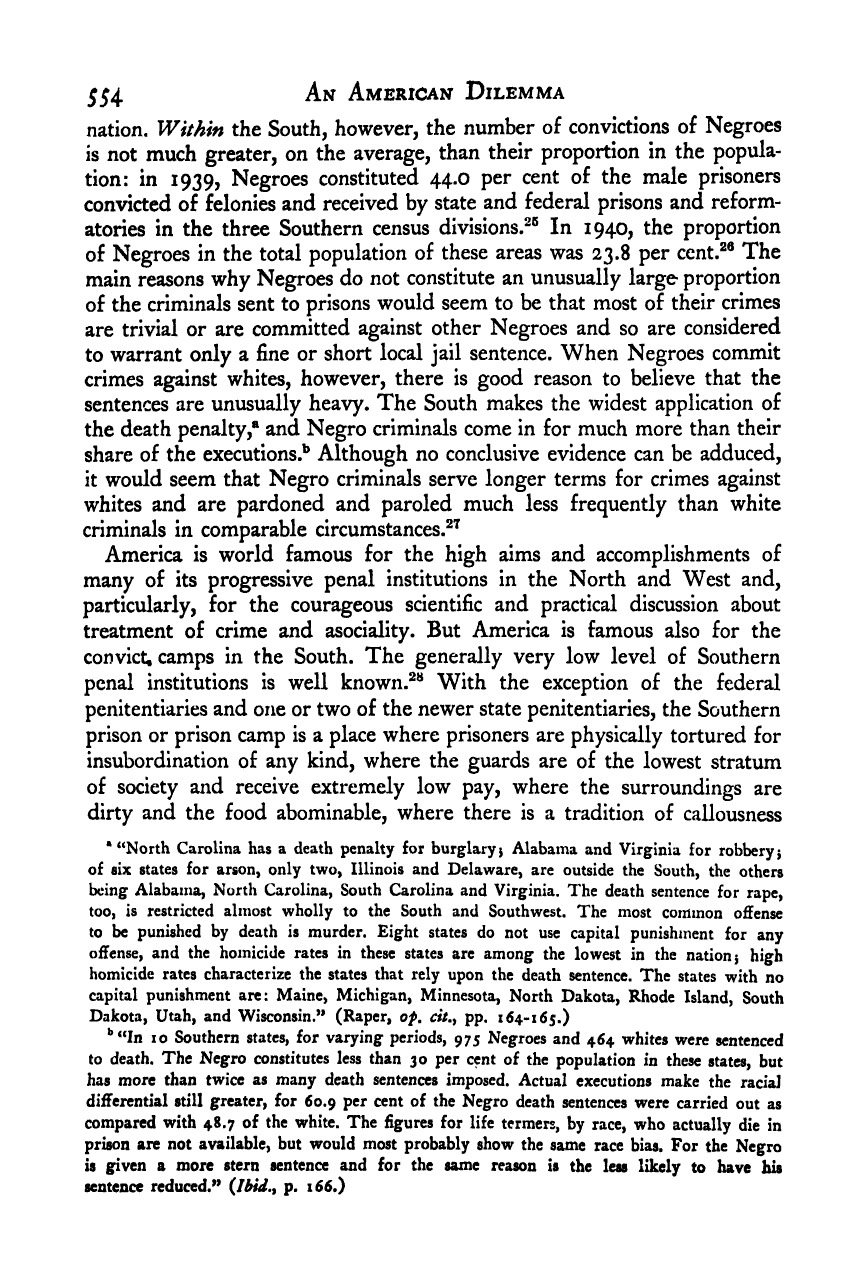Note: Gunnar Myrdal died in 1987, less than 70 years ago. Therefore, this work is protected by copyright, restricting your legal rights to reproduce it. However, you are welcome to view it on screen, as you do now. Read more about copyright.
Full resolution (TIFF) - On this page / på denna sida - VI. Justice - 26. Courts, Sentences and Prisons - 3. Sentences and Prisons

<< prev. page << föreg. sida << >> nästa sida >> next page >>
Below is the raw OCR text
from the above scanned image.
Do you see an error? Proofread the page now!
Här nedan syns maskintolkade texten från faksimilbilden ovan.
Ser du något fel? Korrekturläs sidan nu!
This page has never been proofread. / Denna sida har aldrig korrekturlästs.
554 An American Dilemma
nation. Within the South, however, the number of convictions of Negroes
is not much greater, on the average, than their proportion in the popula-
tion: in 1939, Negroes constituted 44.0 per cent of the male prisoners
convicted of felonies and received by state and federal prisons and reform-
atories in the three Southern census divisions.^® In 1940, the proportion
of Negroes in the total population of these areas was 23.8 per cent.^® The
main reasons why Negroes do not constitute an unusually large proportion
of the criminals sent to prisons would seem to be that most of their crimes
are trivial or are committed against other Negroes and so are considered
to warrant only a fine or short local jail sentence. When Negroes commit
crimes against whites, however, there is good reason to believe that the
sentences are unusually heavy. The South makes the widest application of
the death penalty,® and Negro criminals come in for much more than their
share of the executions.^ Although no conclusive evidence can be adduced,
it would seem that Negro criminals serve longer terms for crimes against
whites and are pardoned and paroled much less frequently than white
criminals in comparable circumstances.^^
America is world famous for the high aims and accomplishments of
many of its progressive penal institutions in the North and West and,
particularly, for the courageous scientific and practical discussion about
treatment of crime and asociality. But America is famous also for the
convict, camps in the South. The generally very low level of Southern
penal institutions is well known.^® With the exception of the federal
penitentiaries and one or two of the newer state penitentiaries, the Southern
prison or prison camp is a place where prisoners are physically tortured for
insubordination of any kind, where the guards are of the lowest stratum
of society and receive extremely low pay, where the surroundings are
dirty and the food abominable, where there is a tradition of callousness
‘“North Carolina has a death penalty for burglary j
Alabama and Virginia for robbery
j
of six states for arson, only two, Illinois and Delaware, are outside the South, the others
being Alabama, North Carolina, South Carolina and Virginia. The death sentence for rape,
too, is restricted almost wholly to the South and Southwest. The most common offense
to be punished by death is murder. Eight states do not use capital punishment for any
offense, and the homicide rates in these states arc among the lowest in the nation} high
homicide rates characterize the states that rely upon the death sentence. The states with no
capital punishment are; Maine, Michigan, Minnesota, North Dakota, Rhode Island, South
Dakota, Utah, and Wisconsin.” (Raper, of, cit.^ pp. 164-165.)
**“10 10 Southern states, for varying periods, 975 Negroes and 464 whites were sentenced
to death. The Negro constitutes less than 30 per cent of the population in these states, but
has more than twice as many death sentences imposed. Actual executions make the racial
differential still greater, for 60.9 per cent of the Negro death sentences were carried out as
compared with 48.7 of the white. The figures for life termers, by race, who actually die in
prison are not available, but would most probably show the same race bias. For the Negro
is given a more stern sentence and for the same reason is the less likely to have his
sentence reduced.” (Jhid,^ p. 166.)
<< prev. page << föreg. sida << >> nästa sida >> next page >>